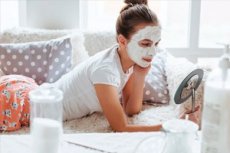New publications
Skin care products can expose children to harmful phthalates
Last reviewed: 02.07.2025

All iLive content is medically reviewed or fact checked to ensure as much factual accuracy as possible.
We have strict sourcing guidelines and only link to reputable media sites, academic research institutions and, whenever possible, medically peer reviewed studies. Note that the numbers in parentheses ([1], [2], etc.) are clickable links to these studies.
If you feel that any of our content is inaccurate, out-of-date, or otherwise questionable, please select it and press Ctrl + Enter.

A recent study published in Environmental Health Perspectives found a link between skin care product (SCP) use in young children and urinary phthalate and phthalate substitute levels. US researchers found that products such as baby lotions and oils were associated with higher urinary phthalate levels, while other products showed no significant association.
Phthalates are endocrine-disrupting chemicals that have been linked to changes in body composition, neurodevelopment, and immune function in children. Young children are particularly vulnerable to phthalate exposure due to their more permeable skin and larger skin surface area to body mass ratio than adults.
Major sources of phthalates include SCPs, food packaging, dust, and medications. Previous studies have examined phthalate exposure in adults or pregnant women, but there is little data on phthalate exposure in young children, especially considering racial and ethnic differences or sex at birth.
A multicenter cohort study collected data from 906 children aged 4 to 8 years. Parents or caregivers completed questionnaires about SCP use in the past 24 hours and provided urine samples for chemical analysis. Products were categorized by type (e.g., with or without phthalates, organic or inorganic). Urine analysis was performed to determine levels of 16 phthalate metabolites and their substitutes.
Diet, physical activity, and other factors were also included. Children were classified by race and ethnicity: Hispanic non-white (NHB), non-white non-Spanish speaking (NHW), Hispanic, and Asian/Pacific Islander (PI).
NHB children had the highest levels of phthalate metabolites, particularly monobenzyl phthalate (MBzP) and monoethyl phthalate (MEP). The association between SCP use and phthalate metabolite concentrations varied by race and ethnicity. For example, body lotion use was associated with increased MBzP levels, and oil use increased MEP levels, particularly in Asian/Pacific Islander and Hispanic children.
It was also found that SCP use varied by sex at birth, resulting in different patterns of metabolite concentrations. Four distinct SCP exposure profiles were identified, with higher exposure levels associated with increased urinary phthalate concentrations.
The study found that SCP use in children aged 4-8 years was associated with specific urinary phthalate metabolite levels that varied by race, ethnicity, and gender. Use of multiple SCPs increased phthalate levels, indicating that they significantly contributed to children’s exposure to these chemicals.
These findings highlight potential inequalities in phthalate exposure and the need for regulatory action on SCP formulation and marketing. Clinicians and advocacy groups can use these results to inform parents about safer skin care product options.
